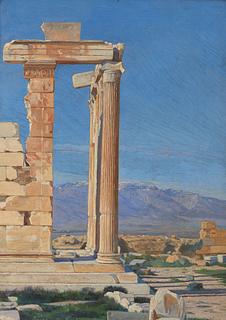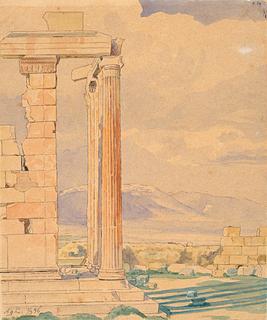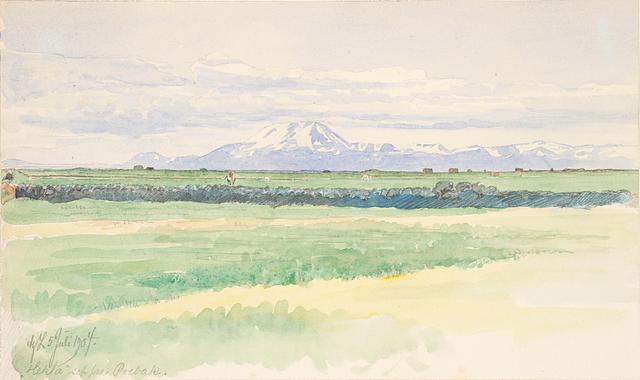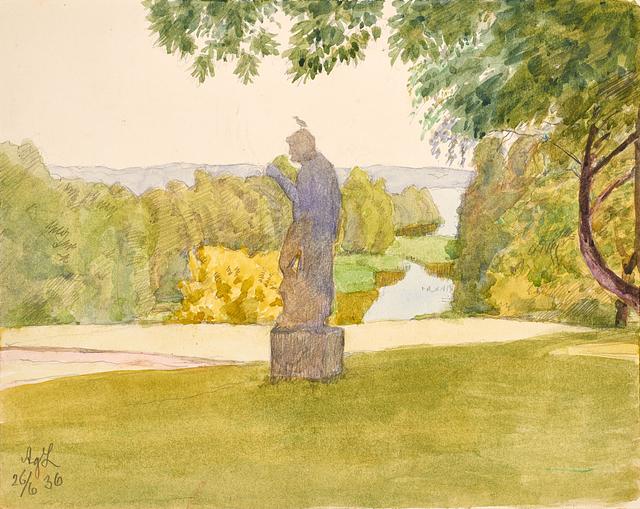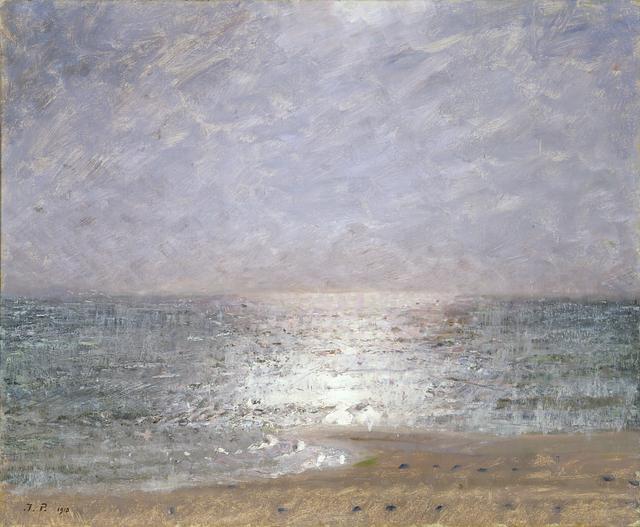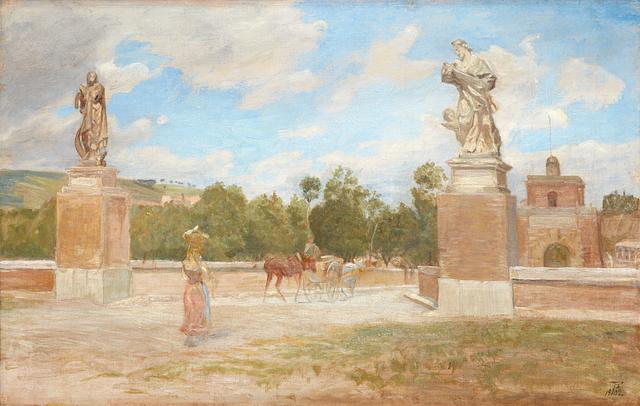Agnes Lunn (1850–1941)
The East porch of the Erechteion, the Acropolis of Athens, 1896
Oil on cardboard
33 x 24 cm
Inventory number B 373
In the years 1880–81, Agnes Lunn studied under the French artist Léon Bonnat (1833-1922) at his Atelier Bonnat in Paris. At that time, the painter Joakim Skovgaard was also studying and working in the French capital. It is therefore reasonable to assume that the close friendship between Agnes Lunn and Joakim Skovgaard began to blossom in earnest in Paris.1
Several years later, in the winter of 1896, Agnes Lunn and Joakim Skovgaard went on a trip together to Greece. They visited the capital, Athens, where Joakim Skovgaard’s younger brother, Niels Skovgaard, had settled for a time with his family and the painter Elise Konstantin-Hansen. Agnes Lunn was based in Athens for a few months. During this time, she created several watercolours and drawings (B 207) in addition to this oil painting, the subject of which is the Erechteion, a temple located on the north side of the Acropolis.
Agnes Lunn painted the scene from the corner of the east porch of the Erechtheion, looking up at the masonry and the large Ionic columns. The architecture is pulled prominently into the foreground, an obviously significant part of the picture. Apparently, it was also important to the artist to depict the solid form of the sand-coloured temple up against the bright blue sky and the mountain landscape behind it, with Mount Parnitha in focus.
The David Collection also owns a preliminary watercolour study for the painting (B 209).
Several years later, in the winter of 1896, Agnes Lunn and Joakim Skovgaard went on a trip together to Greece. They visited the capital, Athens, where Joakim Skovgaard’s younger brother, Niels Skovgaard, had settled for a time with his family and the painter Elise Konstantin-Hansen. Agnes Lunn was based in Athens for a few months. During this time, she created several watercolours and drawings (B 207) in addition to this oil painting, the subject of which is the Erechteion, a temple located on the north side of the Acropolis.
Agnes Lunn painted the scene from the corner of the east porch of the Erechtheion, looking up at the masonry and the large Ionic columns. The architecture is pulled prominently into the foreground, an obviously significant part of the picture. Apparently, it was also important to the artist to depict the solid form of the sand-coloured temple up against the bright blue sky and the mountain landscape behind it, with Mount Parnitha in focus.
The David Collection also owns a preliminary watercolour study for the painting (B 209).
Published in
Published in
Foraarsudstillingen Katalog, Charlottenborg, København 1897, cat. 582 (addendum), p. 48:
Fortegnelse over de i Permanent Kunstudstilling Bredgade 28 udstillede Arbejder af Ellen Jolin, Augusta Dohlmann, Agnes Lunn og J.P. v. Wildenradt i Marts 1898, København 1898, cat. 129, p. 10;
Agnes Lunns mindeudstilling i Efteraarsudstillingen 1942, Charlottenborg, København 1942, cat.no. 50;
Niels Oxenvad: Agnes Lunn. Maleri og Skulptur, Carl Nielsen Museet. Odense 1992, cat.no. 55;
Fortegnelse over de i Permanent Kunstudstilling Bredgade 28 udstillede Arbejder af Ellen Jolin, Augusta Dohlmann, Agnes Lunn og J.P. v. Wildenradt i Marts 1898, København 1898, cat. 129, p. 10;
Agnes Lunns mindeudstilling i Efteraarsudstillingen 1942, Charlottenborg, København 1942, cat.no. 50;
Niels Oxenvad: Agnes Lunn. Maleri og Skulptur, Carl Nielsen Museet. Odense 1992, cat.no. 55;
Footnotes
Footnotes
1.
Agnes Lunn had met Joakim Skovgaard while still a child because he and his father, P.C. Skovgaard, were regular visitors at the Lunn family’s manor house, Knabstrup. See Anne Christiansen: Carl Nielsen-parrets kunstsamling, Odense 2015, p. 104
Paintings and drawings
